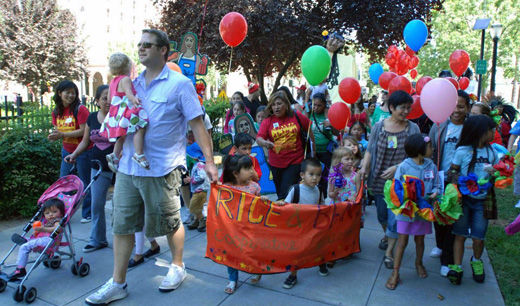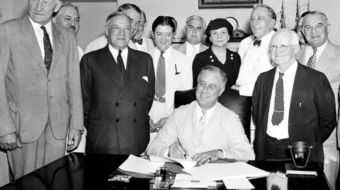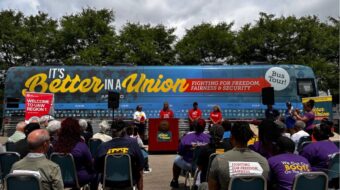
CHICAGO — The AFL-CIO will probe new ways of organizing itself and the broader labor movement and its allies to meet what it says are the changing times. The federation’s president made the first public announcement of this intention here in Chicago yesterday, just a week after leaders of the nation’s unions discussed the idea at an executive council meeting of the AFL-CIO in Orlando, Fla.
Trumka said at that time that when the giant labor federation was first formed “it was very much about us protecting ourselves from each other. The new economy and the attacks on labor and its allies require very new thinking.”
Trumka spoke publically about the plan in Chicago yesterday just prior to a mass rally in the heart of the Windy City’s Latino community at which Chicago unions launched what is, for labor, an unprecedented push for immigration law reform. The Chicago rally is the first of many immigration reform rallies labor is planning in the weeks ahead. Trumka made his organizing remarks at a University of Illinois gathering just prior to the rally. The meeting at the college was titled “Conference on New Models for Worker Representation.”
A major aim of the reorganization, he said, would be to bring together traditional unions with worker centers and other non-traditional types of organizations workers are forming now all over the country. Examples of these are found among domestic workers, taxi cab drivers, carwash workers, immigrant workers, both skilled and unskilled, and others. The AFL-CIO already has affiliate relationships with groups in these categories.
“To be blunt, our basic system of workplace representation is failing to meet the needs of America’s workers by every critical measure. The numbers give us all the proof we need,” he said. Recent reports released by the Bureau of Labor Statistics show just over 11 percent of American workers in unions, down significantly over the last 50 years. Although labor leaders attribute much of the decline to the attacks on labor by the right wing in the recent period and to mass layoffs of union workers during the recession, there is a strong belief among them that only some form of reorganization can ultimately reverse the trend of declining membership.
“Not even 7 percent of the private workforce has the security and stability of a union contract,” Trumka said. “For the past few decades, falling union membership in the private sector was offset by the growth of public unions. But public union membership is now falling, too, partly from job losses caused by the recession, but also because of political attacks.
“Union density has been falling for years, and so has the fate of America’s middle class. A chart of union membership rates and the fortunes of America’s middle class shows twin red lines, falling together. The two are connected. It could not be clearer. This is bad for our economy and this is bad for America.”
Trumka cited several examples of new ways of organizing, pledging the AFL-CIO could use or recommend any or all of them, or more. These included expanding Working America, a pro union organization for workers at non-union companies, which now has 3.2 million members. He also cited the strengthening of partnership agreements with worker centers, the National Day Laborers Network, the Taxi Workers Alliance and related groups that organize workers whose employers call them “independent contractors.” The “independent contractor” ploy is used to deny workers basic rights that both union and non-union workers have at their places of employment.
He also cited making union membership available to individuals who are not characterized officially as “employees” by various firms and said that the Service Employees and the American Federation of State County and Municipal Employees have already been doing this with certain categories of health care workers.
“We are not going to rebuild the labor movement solely through NLRB elections and voluntary recognition by employers, no matter how smart and strategic our campaigns,” he said. “The AFL-CIO’s door has to be-and will be-open to any worker or group of workers who wants to organize and build power in the workplace.”
Photo: Above, a demonstration by the National Domestic Workers Alliance takes place. Unions aim to reorganize so that they can cement their relationship with non-traditional labor organizations such as this one. National Domestic Workers Alliance Facebook page.











